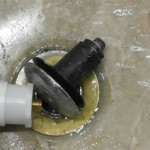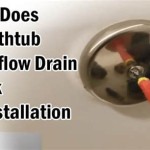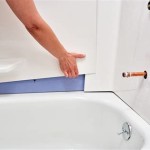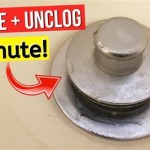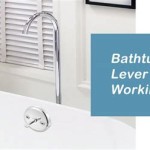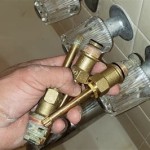How to Remove a Bathtub Surround
Removing a bathtub surround is a common task undertaken during bathroom renovations. It often precedes the installation of a new surround, tile work, or even a complete bathtub replacement. While the process can be time-consuming and requires a degree of care, it is manageable for the average homeowner with the right tools and understanding of the steps involved. This article provides a detailed guide on how to safely and effectively remove a bathtub surround.
It's crucial to prioritize safety before beginning any demolition project. Protective eyewear, gloves, and a dust mask are essential. Surrounds, particularly older ones, can contain fiberglass, mildew, or other irritants that can pose health risks if inhaled or come into contact with skin or eyes. Ensure adequate ventilation in the bathroom by opening windows and possibly employing a fan to circulate the air.
Before starting the removal process, it is important to identify the type of surround. Bathtub surrounds are typically made from acrylic, fiberglass, or tile. Each material requires a slightly different approach for removal. Acrylic and fiberglass surrounds are generally installed using adhesive and sometimes nails or screws. Tile surrounds, on the other hand, are bonded to the wall with mortar or thin-set and require more forceful methods for removal.
Key Point 1: Gathering the Necessary Tools and Materials
Having the right tools readily available will significantly streamline the removal process. Here is a list of essential items:
*Utility Knife:
Used to score caulk lines and seams along the surround edges. *Caulk Remover Tool:
Specifically designed to remove caulk without damaging the surrounding surfaces. *Pry Bar:
A small to medium-sized pry bar is helpful for gently separating the surround from the wall. *Putty Knife or Scraper:
Useful for scraping away adhesive residue. *Hammer:
Primarily for use with the pry bar and for tapping to loosen the surround. *Screwdriver (Phillips and Flathead):
To remove any screws securing the surround. *Reciprocating Saw (Optional):
May be needed for cutting large sections of adhesive or stubborn areas. Use with caution. *Multi-Tool with a Cutting Blade (Optional):
Provides precise cuts in tight spaces. *Safety Glasses:
Absolutely essential to protect eyes from debris. *Gloves:
Protect hands from cuts, scrapes, and irritants. *Dust Mask or Respirator:
To avoid inhaling dust and particles, especially when dealing with fiberglass or mold. *Drop Cloths or Plastic Sheeting:
To protect the bathtub and surrounding floor from debris. *Trash Bags:
For efficient disposal of removed materials. *Shop Vacuum:
To clean up dust and debris throughout the process. *Stud Finder:
Locate studs to avoid accidentally damaging plumbing or electrical wiring. *Pencil:
For marking cut lines if sectioning the surround.This comprehensive list ensures preparation for various challenges that may arise during the removal process.
Key Point 2: Step-by-Step Removal Process for Acrylic or Fiberglass Surrounds
The following steps outline the removal process for acrylic or fiberglass bathtub surrounds:
Preparation:
Lay down drop cloths to protect the bathtub and surrounding floor. Ensure adequate ventilation and wear safety glasses, gloves, and a dust mask.Caulk Removal:
Use a utility knife and caulk remover tool to carefully cut and remove all caulk around the perimeter of the surround where it meets the bathtub and walls. This is a critical step, as caulk is a primary sealant and adhesive.Locate and Remove Fasteners:
Inspect the surround for any visible screws or nails. Use the appropriate screwdriver or a nail puller to remove them. Check along the edges and corners, as these are common locations for fasteners.Initial Separation:
Start at a corner or edge of the surround. Gently insert a putty knife or scraper between the surround and the wall. Work it back and forth to begin separating the adhesive bond.Pry the Surround:
Once a small gap has been created, insert a pry bar. Use light pressure to gradually pry the surround away from the wall. Work slowly and carefully to avoid damaging the wall behind it. If the surround is proving difficult to remove, use the utility knife or multi-tool to score the back of the surround along the stud lines; this might help weaken the adhesive's grip.Address Stubborn Adhesive:
If sections remain stubbornly attached, use a reciprocating saw or multi-tool with a cutting blade to carefully cut through the adhesive. Be extremely cautious not to damage the wall studs or any hidden plumbing or wiring. The stud finder can assist in locating framing.Remove Adhesive Residue:
After the surround is removed, use a putty knife or scraper to remove any remaining adhesive from the wall. For stubborn residue, consider using a solvent-based adhesive remover (always follow the manufacturer's instructions and ensure adequate ventilation).Clean Up:
Thoroughly clean the area with a shop vacuum to remove dust and debris.
These steps, executed with care and patience, should result in a successful removal of a fiberglass or acrylic surround.
Key Point 3: Removing a Tile Bathtub Surround
Removing a tile bathtub surround presents a different set of challenges due to the inherent rigidity and bonding strength of tile and mortar. Here's a detailed approach:
Preparation:
As with other surrounds, protect the bathtub and floor with drop cloths. Wear safety glasses, gloves, and a dust mask; tile removal generates a significant amount of dust.Grout Removal:
Before attempting to remove the tiles, remove as much grout as possible. Use a grout removal tool or a reciprocating saw with a grout removal blade. This weakens the bond between the tiles and makes removal easier.Initial Tile Removal:
Begin at a corner or edge. Use a hammer and chisel to carefully chip away at the grout lines and pry the first tile loose. Apply steady, controlled blows to avoid damaging the surrounding wall excessively.Tile Removal Technique:
Once the first tile is removed, continue the process, working from the initial opening. Position the chisel at an angle behind the tiles and gently tap with the hammer. The goal is to break the mortar bond without shattering the tiles.Addressing Stubborn Tiles:
Some tiles may be more difficult to remove than others. For these, a larger hammer and more forceful blows may be necessary. However, exercise caution to avoid damaging the wall studs. Consider using a demolition hammer or small jackhammer for large, heavily bonded areas, but do so carefully and with appropriate safety equipment.Mortar Removal:
After removing the tiles, the wall will likely be covered in mortar residue. Use a scraper or chisel to remove as much of the mortar as possible. A power scraper can be helpful for large areas.Inspect and Repair Wall:
Once the mortar is removed, inspect the wall for any damage. Repair any cracks or holes with patching compound before installing a new surround or tile.Clean Up:
Thoroughly vacuum the area to remove dust and debris.
Removing a tile surround is a more labor-intensive process but can be successfully completed with methodical work and the proper tools.
Following these steps, regardless of surround type, ensures a safer and more efficient removal process. Remember to prioritize safety, take your time, and adapt your approach based on the specific challenges encountered.
Proper disposal of the removed surround material is also important. Check local regulations regarding waste disposal. Certain materials, like fiberglass, may require special handling or disposal methods.
Finally, after the old surround is removed and the area is cleaned, the bathroom is prepared for the next phase of the renovation project. This might involve installing a new bathtub surround, tiling the walls, or painting the exposed wall surfaces.

How To Remove A Fiberglass Bathtub And Surround By Home Repair Tutor

Tub Surround Removal Shower Replacement Course

Semi Diy Bathroom Remodel Replacing A Tub Surround The Bathtub Tile

How To Remove A Fiberglass Bathtub And Surround By Home Repair Tutor

Semi Diy Bathroom Remodel Replacing A Tub Surround The Bathtub Tile

How To Remove And Replace A Bathtub The Home Depot

How To Remove And Replace A Bathtub The Home Depot

How To Remove And Replace A Bathtub The Home Depot

Semi Diy Bathroom Remodel Replacing A Tub Surround The Bathtub Tile

How To Remove Shower Wall Panels Hunker
Related Posts

